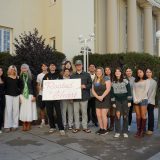The Quintessential Los Angeles Artist (Ed - Werd Rew - Shay)
December 14, 2015
Raised in Oklahoma City, American artist Ed Ruscha (b. 1937) was first introduced to art through popular culture, looking at comic books, cartoons, and Disney films as inspiration. Attracted to the energy of Los Angeles, Ruscha moved there in 1956 at the age of eighteen and attended the Chouinard Art Institute, now the California Institute of the Arts.
During this time, Abstract Expressionism dominated the art world, yet Ruscha instead became influenced by the works of Jasper Johns and Robert Rauschenberg, who were introducing relevant and recognizable images to their works in a way similar to Marcel Duchamp’s use of found objects. As Ruscha graduated from art school, the Pop art movement was beginning to gain attention in the art world and Ruscha was quick to feel the changing pulse.
Infatuated by the city of Los Angeles, the young artist began using the city as inspiration for his works. Using everything from paint, photography, drawings and a quick foray in film, Ruscha explored the possibilities of these mediums during a very transformative period in art history. His one- word paintings soon became his iconic style, using these words in a Duchampian manner. Words like “Oof,” “Ripe,” “Smash,” and “Noise” were painted on backgrounds of solid color, emphasizing the aesthetic and connotative meaning of the words. These paintings evolved over time, turning into multi-word phrases that struck the artist’s interest like “Guacamole Airlines,” “Pay nothing until April,” and longer phrases such as “In California you chew the juice out of the grapes and spit the skin away, a real luxury.” These words and phrases highlight Ruscha’s surrealist interests and the Los Angeles culture that is embedded in his work.
In the 1960s, cars became an integral part of American culture, representing the highest luxury item available to the working middle class American, symbolizing freedom, mobility, and the booming post- war economy. Cars were a common theme in the works of the Pop artists such as Andy Warhol and James Rosenquist. Ruscha not only used car culture as subject matter, but also as a tool for many of his photographic projects, such as Twentysix Gasoline Stations, 1962, Every Building on the Sunset Strip, 1966, and the Royal Road Test, 1967. In Chapman’s own collection, we can evidently see the influence of cars and the landscape of Los Angeles. Pico and Sepulveda and Motor City are both currently on display in Beckman Hall and placed in dialogue with Rauschenberg, mentioned above as being one of his primary artistic influences.

Ed Ruscha: Pico and Sepulveda, 2001
Ruscha’s works provoke discussions on consumer culture, the use of found images, and the city as a source of inspiration for the artist. His sleek, clean aesthetic and cool detachment from any personal biography was attractive to collectors from the very beginning of his career and his popularity has certainly not diminished in the art market today.





